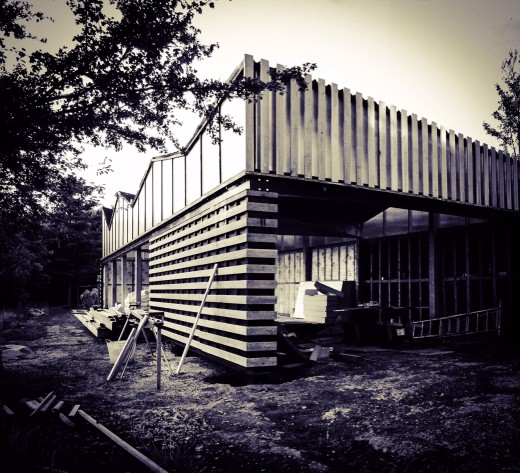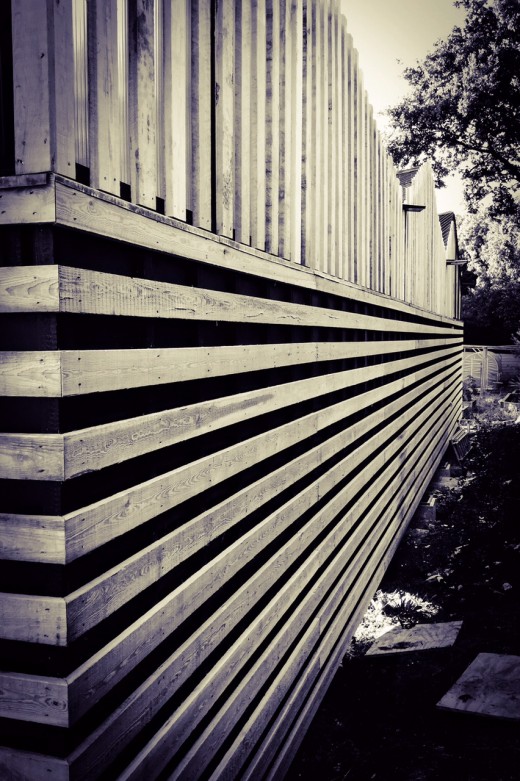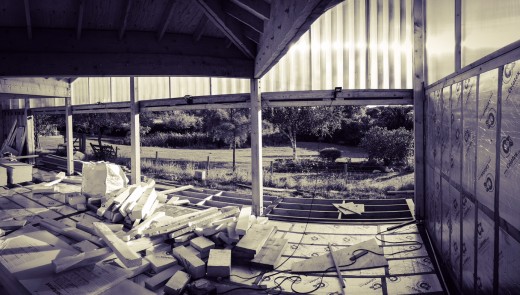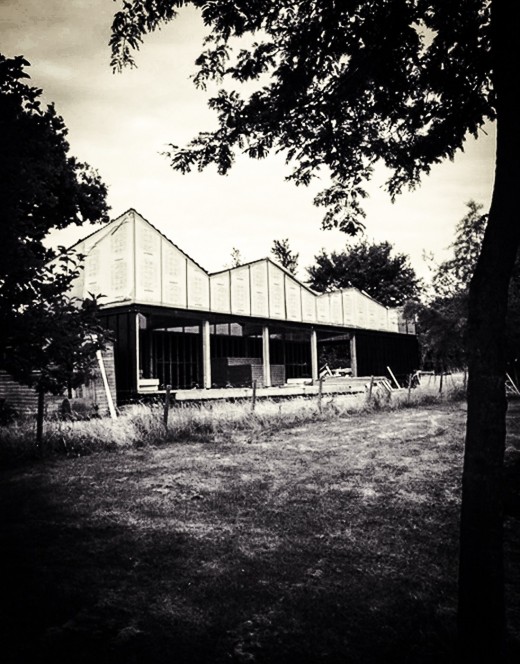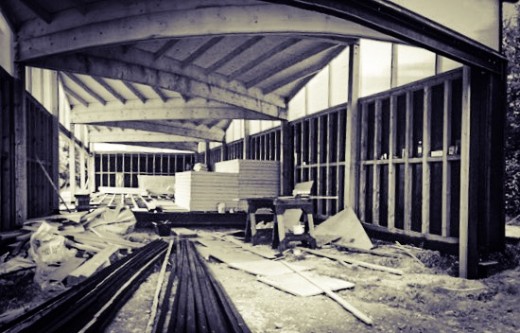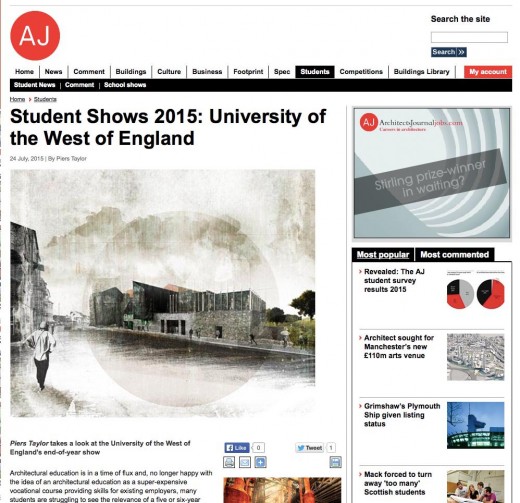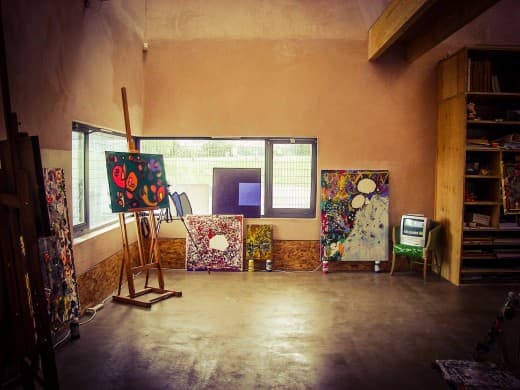 Room 13, 9 years 0n. This is the art studio we designed in 2006 for a then ‘failing’ Bristol School that was in special measures. The charitable programme Room 13 works with excluded children alongside resident artists. The children can have access to the studio anytime, regardless of the curriculum, and they also are the administrators of the studio. The project won a RIBA award, and also a sustainability award.
Room 13, 9 years 0n. This is the art studio we designed in 2006 for a then ‘failing’ Bristol School that was in special measures. The charitable programme Room 13 works with excluded children alongside resident artists. The children can have access to the studio anytime, regardless of the curriculum, and they also are the administrators of the studio. The project won a RIBA award, and also a sustainability award.
Pleasure Gardens Build Up Studio
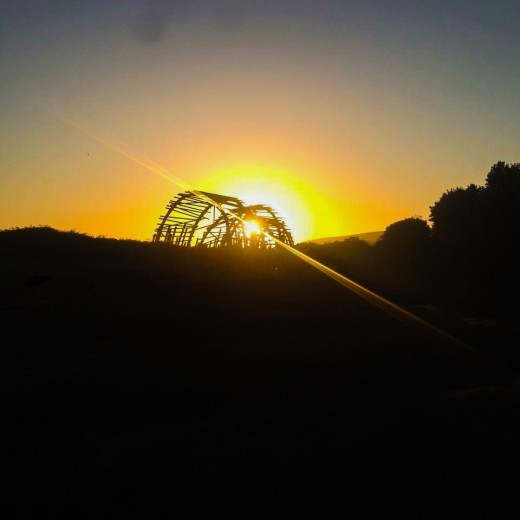
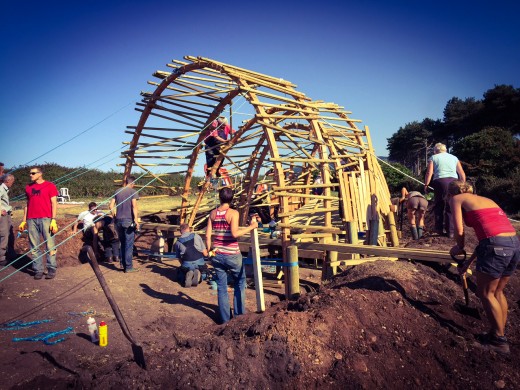
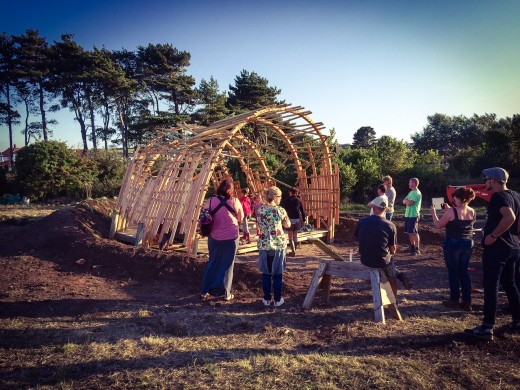
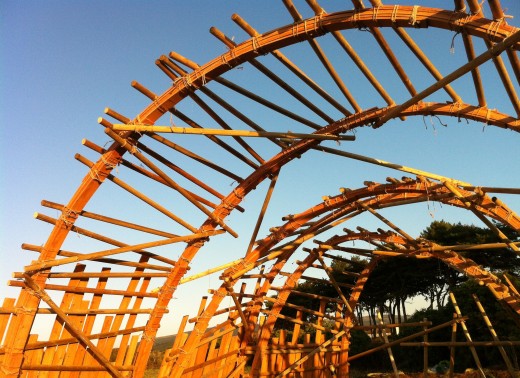

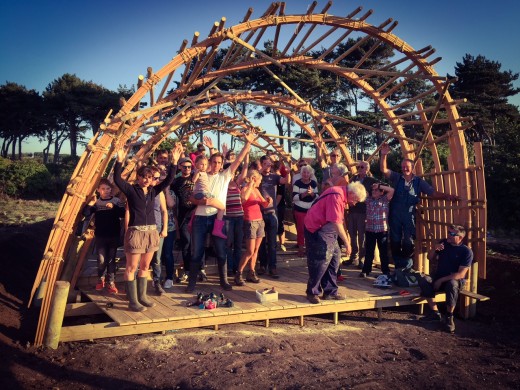
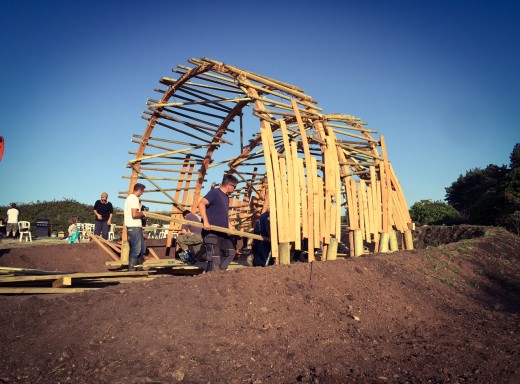
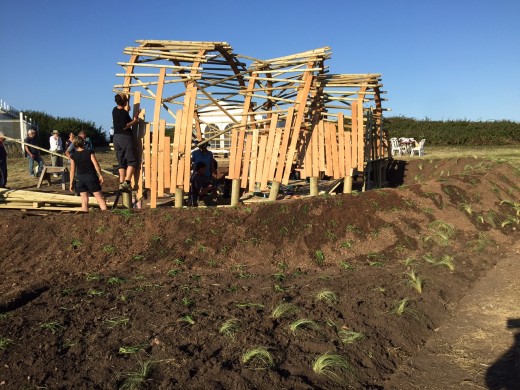
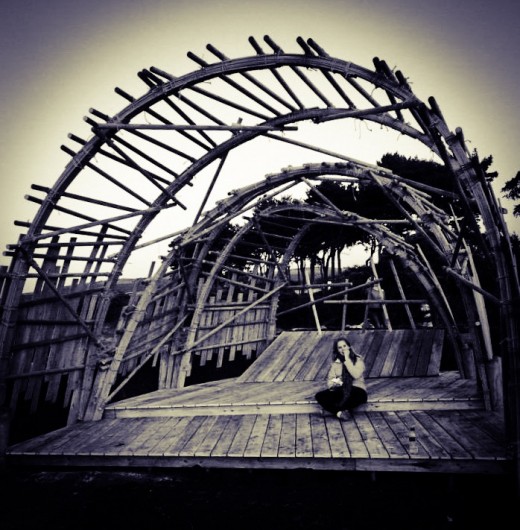 Onion Collective CIC organised an extraordinary weekend in Watchet where Piers Taylor, Charley Brentnall and Marc Dix of LT Studio led a workshop to construct, with up to 50 local volunteers a timber canopy and stage with a planted landscape that marked the reclaiming of the overgrown former pleasure gardens for community use.
Onion Collective CIC organised an extraordinary weekend in Watchet where Piers Taylor, Charley Brentnall and Marc Dix of LT Studio led a workshop to construct, with up to 50 local volunteers a timber canopy and stage with a planted landscape that marked the reclaiming of the overgrown former pleasure gardens for community use.
The structure was made from a series of dry laminated green timber hoops that were bound together with jute rope and no mechanical fixings and few tools. These were bent into shape which effectively tightened the bindings, which will grow even stronger as the rope shrinks when wet and the timber seasons. Many of the volunteers were ‘unskilled’ in the formal sense – and the project is testament to the power of a community coming together to do something for itself.
See completed project images HERE
Julian Marsh’s Meat Factory
Indeterminate Space
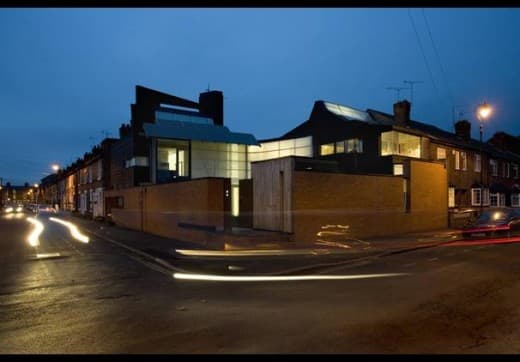 Recently, I went to film the Marsh House in Nottingham by Marsh:Grochowski for the next series of ‘The House That £100k Built. The house completely bowled me over – more so than almost any other house I’ve seen. I’d known the house through photographs in journals, but seeing it in the flesh made me realize what a truly remarkable building it is. In almost everything the house does, there is an extraordinarily lesson for domestic architecture.
Recently, I went to film the Marsh House in Nottingham by Marsh:Grochowski for the next series of ‘The House That £100k Built. The house completely bowled me over – more so than almost any other house I’ve seen. I’d known the house through photographs in journals, but seeing it in the flesh made me realize what a truly remarkable building it is. In almost everything the house does, there is an extraordinarily lesson for domestic architecture.
The house is is Julian Marsh’s own, and where he lives with his partner artist Jude Liebert, and Jude’s brief to Julian was ‘let’s just have a little flat, with loads of space underneath to make stuff’. Julian calls this space ‘indeterminate space’, and I think it is just about the most important space houses can have. It made me realise just how strangled we are by these terrible little room designations we are so quick to give our houses – the kitchen, the living room, and so on. What we all really need is indeterminate space, which we can use for anything we choose, and occupy differently as needs change, and seasons change. Really good spaces are defined by light, structure, scale, materials and views – not labels purporting to describe (and, usually, limit) function.
The big organizational strategy for the house is to group the living spaces around a south facing growing courtyard with a south facing unheated internal wintergarden cooling the internal spaces in summer and heating them in winter. The wintergarden is a pretty radical thing, as it contains all the circulation space and stairs, meaning that Julian and his partner have to go into an unheated space to get from their bedroom to their kitchen even in the depths of winter.
Having a brilliantly well considered environmental strategy means that the space will never drop below 12 degrees, even in the middle of a harsh winter, but it’s still a pretty radical proposal for living that flies in the face of the culture of sealing up buildings, where having one uniform and stable internal environment is now the norm. As well as every other strategy, the environmental strategy of the house challenges pretty much every building fundamental, and offers hope for those of us who feel strangled in red tape.
Natural ventilation featuers large in Julian’s house. There are clear and defined ventilation paths through the building, with windows, flaps and vent panels that need to be adjusted and operated – a little like sailing a yacht. Julian’s principle of using natural ventilation comes as a big relief for me, in an age where the culture of airtightness is becoming the norm. It is also a relief to see someone challenge basic assumptions, and find a method of using building regulations to support, rather than strangle, his vision.
One of the other fascinating things in Julian’s house is how he has used his environmental strategy to define much of the architecture, from the big picture of what the building looks like, how it is laid out, right the way through to the detail. The environmental strategy is visible in the overall form of the building (with it’s greenhouses on the roof, drawing air up through the house), but it is the detail, in particular, that is a real joy. In the wintergarden there is a sublime double height wall which acts as a heat sink – the wall is designed as a series of precast lintel ‘shelves’ with thousands of clear plastic bottles filled with water stacked on them. This is beautiful and decorative, but also highly functional. Water is thermally dense, and consequently all the bottles contribute to the thermal mass of the wall. Simple, low tech, cheap, and beautiful.
It is this kind of resourcefulness that makes the house sing. Freed from the tyranny of having conventional ‘bedrooms’ with his idea of indeterminate space Julian and his partner have a simple thick curtain they pull around the bed at night to keep the light out – and there’s masses of light, as Julian has a penchant for what he calls the ‘sneaked view’ – windows that are sneaked in where you least expect them in order to open up an unexpected view. The sneaked view is such a playful and fun idea, and this spirit of playfulness is everywhere in the house.
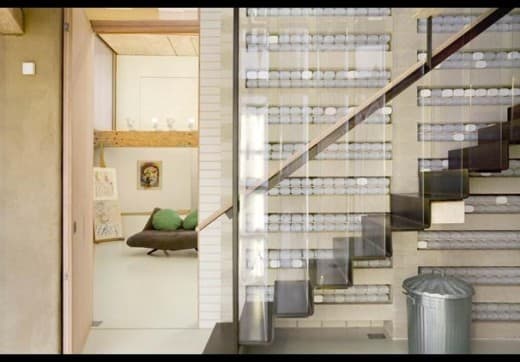 Julian knows the important of the materials that you touch, and consequently has invested time in door reveals, thresholds and simple posts for hand rails that are bound with the most perfect piece of coloured rope at exactly the point your hand falls. This means the remainder of the materials can be functional in the best sense of the word – all the thermally massive precast concrete soffits are exposed, as are the recycled timber ‘Parallam’ beams, and the plastic meat packing curtain balustrades.
Julian knows the important of the materials that you touch, and consequently has invested time in door reveals, thresholds and simple posts for hand rails that are bound with the most perfect piece of coloured rope at exactly the point your hand falls. This means the remainder of the materials can be functional in the best sense of the word – all the thermally massive precast concrete soffits are exposed, as are the recycled timber ‘Parallam’ beams, and the plastic meat packing curtain balustrades.
The whole house made me wonder why on earth so many of us start with such a misguided idea about ‘rooms’ when we start to design – rather than wrapping an extraordinary series of spaces around an idea of how we might live. There’s a terrible and mean tyranny in estate agent speak that is used to describe houses, and if any of us aspire to beautiful and appropriate spaces that support rather than throttle the way we live, we must go beyond narrow presumptions around domestic space.
We also need to go beyond Building Regulations. So often I hear the excuse ‘Oh, Building Regulations won’t let me’ as an excuse not to try something interesting, but as Julian has shown, there is usually a way round regulations, which are there more for guidance than anything else, and are certainly not design tools. It is this spirit of navigating around obstacles and problems that leads, as Julian has shown, to interesting solutions, and it is this spirit that I encourage self-builders to embrace. Dream up the spaces you most want to live in, and then find a way to use regulations to support, not throttle your vision.
© Piers Taylor, 2015
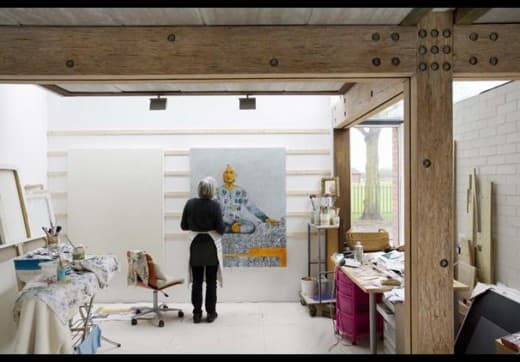
No Longer the West Country Underdog
Piers Taylor’s review of the UWE end of year show 2015 for the Architects’ Journal
 Architectural education is in a time of flux and, no longer happy with the idea of an education as a super-expensive vocational course providing skills for existing employers, many students are struggling to see the relevance of a 5 or 6 year study period that doesn’t ultimately equip them with the skills to be able to come to practice on their own terms.
Architectural education is in a time of flux and, no longer happy with the idea of an education as a super-expensive vocational course providing skills for existing employers, many students are struggling to see the relevance of a 5 or 6 year study period that doesn’t ultimately equip them with the skills to be able to come to practice on their own terms.
As a discipline we seem to be in danger of losing our moral compass and sense of purpose as we head for where the money is and subsume any personal ethics beneath those of our clients. Architecture – as any of the arts – needs rethinking by each successive generation of students who ultimately need to be given the critical framework to be able to invent their future.
The default position of many mainstream schools of architecture is simply to teach architecture as the crafting of a static object, presented as a thing of shallow beauty, and perpetuating a way of doing architecture that has been pretty fixed for several generations. It’s kind as if the social issues raised by Modernism or the 1960s never happened, and if ever architectural education needs to change, it is now.
More than anything, architecture schools need to broaden to equip students with the ability of dealing with the mess and chaos of reality with all its glorious dirt and grit. Architectural education needs to change to embrace other and alternative skills needed for architects to act convincingly in the world. This include developing the adroitness for engagement with real and local communities, for tackling environmental issues, for engaging with the concerns of planning policy and, more importantly, engaging with planning at a strategic level. As it happens, this is exactly what UWE are doing.
From an almost standing start and in only a few years, with the extraordinarily energetic Elena Marco at the helm UWE has successfully reinvented itself as a school that is addressing head on the need for architectural education to diversify. UWE’s current courses are unusually wide ranging, and the school adopted early on a joint programme of architecture and planning, and has built on this successfully.
Planning – long seen as architecture’s less glamorous cousin – is now a field in which many architects are realising the real design happens. It is where the big picture is defined, the context is framed and strategies for change created. Planning – rather than merely architecture – is where the future is invented. As Vincent Lacorava has shown in his move from AOC to Croydon Borough Council, planning can be truly exciting and supremely powerful. It is surprising that more universities have not followed UWE’s lead and incorporated planning into the core of the main degree courses. In addition to planning, UWE also have a new dual architecture and environmental engineering degree with RIBA /CIBSE accreditation.
At the end of year show, most of the work I saw was from the final (MArch) year, which is overseen by Rachel Sara (author of Architecture and Transgression). Sara has successfully embedded a stand-alone research module into the core projects, and this translates into a set of student projects that have real depth. Far from focusing on the design of a single building, the diploma projects take on far wider issues, often in places that benefit from architecture the most.
It is a delight to see is students give design its dignity back, and produce work that understand that design can be a tool for delivering vicissitude and innovation, delivered in a grass roots, bottom up way. More than ever, I saw evidence of how design can be a tool for change. It was also a joy to see so many of the students tackle the essential issues of urbanism, reuse and sustainability so convincingly. With projects rooted in these pressing concerns and thorough research one could have almost forgiven the students had they not delivered interesting built proposals, but here too, almost without exception, were a set of buildings that were delightfully eclectic, materially and tectonically rich, and spatially diverse.
UWE is showing how, away from the razzle-dazzle of the big city, from a campus that is a close cousin of a business park, there is a way of doing things differently. Not just differently, but better, as evidenced in work that is rich, quirky, layered, convincing and clever, produced by autonomous and individual students who seem fearless at entering into a static world and creating change. What a long way UWE has come in recent years. Still the West County underdog? I don’t think so.
© Piers Taylor 2015
Categories
- 100k house
- Articles
- brexit
- Caretaker's House
- Christchurch
- current
- East Quay Watchet
- film
- ghost barn
- Glenn Murcutt
- Heroes
- Hooke Park
- House in an Olive Grove
- Invisible Studio
- longdrop
- Mess Building
- Moonshine
- On the Road Again
- passihvaus
- piers taylor
- piers,taylor
- press
- Projects
- Riverpoint
- Self Build
- Stillpoint
- Studio Build
- Studio in the Woods
- talks
- Trailer
- truss barn
- Uncategorized
- Vernacular Buildings
- watchet
- Westonbirt
Tags
- caretaker's house
- design and make
- Design Build Workshop
- Design Make
- east quay
- east quay watchet
- Glenn Murcutt
- green timber architecture
- Hooke Park
- Hooke Park Big Shed
- Invisible Studio
- Low Impact House
- moonshine
- Onion Collective
- piers taylor
- Piers Taylor Architect
- piers taylor invisible studio
- self build
- self build architect
- Starfall Farm
- Stillpoint Bath
- studio in the woods
- Sustainable Architecture
- The house that £100k built
- timber architecture
- Timber House
- timber workshop
- visible studio
- westonbirt architecture
- westonbirt tree management centre
